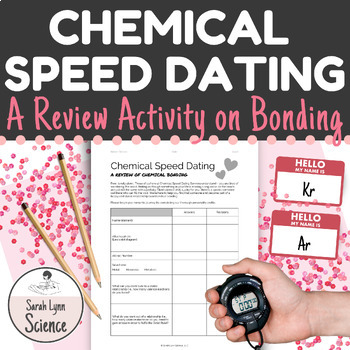Chemical Speed Dating: A Review Activity on Chemical Bonding
- Zip
What educators are saying
Description
This chemical bonding review activity reinforces student knowledge of ionic and covalent bonds using a fun speed dating simulation! Low prep and interactive, this complete high school lesson plan is a great choice for chemistry and physical science classrooms year round – and it makes an awesome holiday activity around Valentine’s Day!
Who Is This Product For?
The Chemical Speed Dating activity is best suited for secondary chemistry and physical science students who need to have a solid understanding of chemical bonding and are mature enough to have fun with a speed dating simulation.
What Is Speed Dating and What Is Included in This Product?
Speed dating is an activity in which adults gather at a designated event in order to meet many people in a short amount of time. Typically, women are seated at the event while the men rotate between them at specific intervals. The event is over when each man has had the opportunity to go on a ‘date’ with each woman.
This activity mimics the structure of a speed dating event. Students are each given an element, which become their dating personas, and are tasked with finding someone they can ‘bond’ with!
Included in Your Purchase:
- Chemical Speed Dating Lesson Plan with answer key and sample student responses
- Chemical Speed Dating student handout
- Color-coded element cards (enough for a class of 36)
- Terms of Use Agreement
When & Where Should This Product Be Used?
This activity works best in large classes so there are enough ‘dates’ for everyone! It should be facilitated after students have received lessons on both ionic and covalent bonds. Students need to have knowledge of the following in order to be successful during this interactive review game: Lewis dot diagrams, atomic number, types of elements (metals, nonmetals, and metalloids), valence electrons, and the Octet Rule.
Product Details:
- 8th – 11th
- Possible Courses: Physical Science, Chemistry, Biology
- Standards Alignment:
- NGSS Core Idea PS1.B
- Arizona State Science Standards HS+C.P1U1.1
- Mode of Learning: In-person
- License Agreement: Single classroom use by original purchaser
Why & How Should This Product Be Used?
Are you looking for a fun activity to finish off your lesson on chemical bonds? Do you want to reinforce the rules of ionic and covalent bonding in a way engages students both mentally and physically? Are you looking to try a new type of review game in your classroom? If you answered yes to any of these questions, then Chemical Speed Dating is for you!
Here are some things that make this product amazing!
- Low Prep: This chemistry review game is a time saver! The only things that need to be cut out are the element cards – everything else is ready to go as soon as it’s been printed!
- Engagement: Students love the fast-paced and collaborative nature of this task. It definitely won’t be forgotten!
- Formative Assessment: The student handout for this activity includes an area for revisions, so you can assess students on the go while maintaining a record of areas of difficulty. You can then use this data to reiterate key concepts before administering a summative assessment.
Some potential uses for this resource include:
- Apply! Use this activity shortly after your lesson on chemical bonding so students can practice applying their new knowledge.
- Reinforce! Refresh students on the key concepts when you see that they need to touch up.
- Review! Facilitate this activity prior to a formal assessment so students get the opportunity to review with you and their classmates.
So, what are you waiting for? Let this review activity work for you!
Tips & Tricks:
Want to earn TpT credits that you can use to get free products? All you have to do is rate and review your purchases! Details about how this program works can be found here.
If you like this product, remember to follow me and get exclusive updates! Not only will this keep you in the loop, it’ll also provide support to me and my store, allowing me to continue creating awesome products for your classroom. Thank you for your support!
Happy teaching,
Sarah Lynn Science





